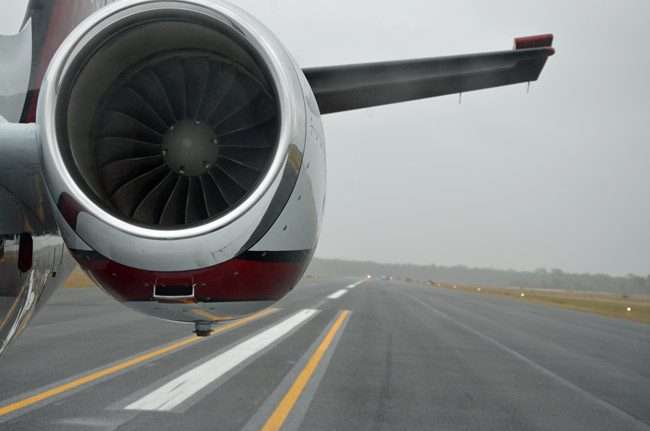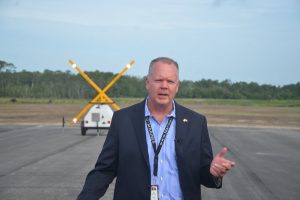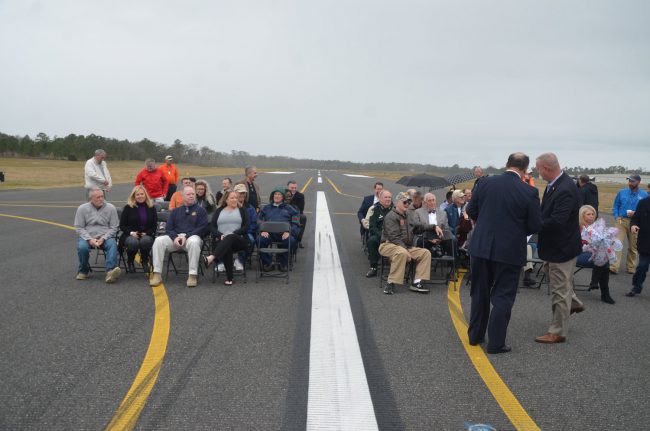
Roy Sieger sometimes sounds like a kid in a candy shop, a 1,150-acre candy shop: that’s the size of the Flagler County Executive Airport he manages. “This is awesome. I love doing projects at this airport, I love being the airport director,” he told a small group of government, business and airport officials this morning as he stood on the airport’s newest addition: a $17 million, 5,500-foot runway he was officially dedicating in a ribbon-cutting, more than two decades after it was conceptualized, in 1996.
He loves the job so much that this was the fourth time in seven months he’d invited press and public to share his excitement. The first time was last June, for the ground-breaking on the runway, dubbed then and now as the most expensive project undertaken at the airport in its 75-year history. The second time was for a press tour of the entire grounds, including the control tower. The third time, in October, was for the inaugural flight off the new runway, known as Runway 11-29. And the fourth—attended, like the first, by every county commissioner and then some: ex-commissioner George Hanns was also there—was today, hurried though it was because just as Sieger began speaking, gray skies forming what in airport parlance was a very low ceiling began spitting a cold drizzle. It was just as well: the assembled had heard the story of the runway enough times and lunch was beckoning in a hangar not far away.
They heard the required words, stood for the ribbon-cutting, stood for selfies or photographs with others, and walked on the carpet-like asphalt. It wasn’t any old asphalt. It’s lined with quarter-inch deep, quarter-inch wide groves every inch and a half, the better to create traction for landing and departing planes. Some 29,000 tons of asphalt was brought in by 1,450 trucks and spread over the new runway into what would equate to the equivalent of 20 highway miles, with 100,000 square feet of airfield paint striping from 1,000 gallons. The old runway was milled into 1.8 million square feet of asphalt milling and is being recycled elsewhere on county roads. The runway itself was a little over $12 million, with the Federal Aviation Administration assuming $9.33 million of that, the state Department of Transportation paying $2.72 million, and the airport paying $128,000.

The very last take-off from the old runway took place last July 27 as Sieger himself and pilot John Rising went up in a T-6—appropriately, a World War II training plane. The airport was built by the military as part of that war’s efforts. The first take-off from the new runway took place on Oct. 24 in an IAI Westwind jet piloted by Tripp Wacker.
Not that it would matter to most but the runway itself was moved 400 feet to the south and got a 500-foot extension to the east, while the old runway was turned into a parallel taxiway. The airport’s two runways accommodate 500 takeoffs and landings per day on average at the airport, 60 percent of them flight training. The two runways enable pilots to choose the best way to land and take-off into the wind. More than 400 LED airfield and guidance signs were installed as part of the runway project.

The airport is a so-called government enterprise fund, which means that it runs like a business, independent of tax dollars. “We make a profit of about $600,000 a year. It stays in the airport,” Sieger said during one of those visits with the press. Airport dollars are generated from hangar leases, building leases and fuel sales. It’s public money, but it’s not tax dollars. The airport has a staff of six, Sieger included.
There are further plans ahead, chief among them a planned 12,000 to 14,000 square foot general aviation terminal. The design alone will cost $350, 000 to $400,000. Construction will cost $3.5 million to $4 million. It’s expected to be done “within the next three years,” Sieger said, with funding from the transportation department and, depending on how the grant is structured, 20 percent from the airport fund. “We’re going to build it so we can actually have some businesses in there,” Sieger said. He envisions another car rental business and a flight school. County Administrator Craig Coffee sees perhaps a restaurant overlooking the flight operations.
![]()
The first flight off the new runway, in October:




























Dave says
So when can we actually use this airport to travel? Until then all this means nothing to 99% of the citizens in Flagler County
David says
Actually it means a lot to the county. With increased air traffic and growth, there is an increase in tax revenue. The question should be, will there ever be commercial passenger air service at this airport.
Anonymous says
What are the underlying assumptions and the projected cash flow associated solely with the $17 million of sunk runway cost? Additional fuel sales alone would seem unlikely to provide sufficient margin to justify the cost. Look at a convenience store; they make money on beer, milk, and cigarettes rather than gasoline. Just because “others” paid the majority of the cost doesn’t mean it made business sense to spend these funds as the breakeven period likely exceeds 10 years.
Just the truth says
That kind of money being spent for just private air planes? Seems like a waste of money.
Mike, pilot says
First, Flagler county residents didn’t pay for this – 95% of it is funded by the FAA from airline ticket taxes. Airports are like the interstate highway system, they are a “public good” and an item of infrastructure. Communities that don’t have an airport can’t attract businesses and jobs, they become dying backwaters. There are many uses for airports other than jetliners – medevac flights, emergency response services, flight training, you happen to have a pretty good restaurant there and you don’t have to be a pilot to eat there, Airports bring plenty of direct employment and plenty of indirect employment. Look at http://www.fdot.gov/aviation/pdfs/Flagler%20County.pdf and you will discover that Flagler airport generates $121,000,000 a year in direct and indirect benefits. NONE of that is airliners, it is ALL general aviation.
Anonymous says
Mike, thank you for defending the airport’s economic impact based on its historic footprint. Everything you noted was already available. Individuals are rightly questioning the incremental cost compared to the incremental benefit. Perhaps the FAA’s funds would be better spent on modernizing the air traffic control system than positioning Flagler County to open another restaurant.
Really says
How bout fixing the roads we drive on every day. Ive never taken flight from thst airport. The Govt paid for most of it( our $ anyway) and with a staff of six it creates what in employment. Sounds like another pet project from somebody ( one) sitting behind a title and desk somewhere.
richard says
Not sure if money spent to have another restaurant onsite is very wise. High Jackers has been there since 2001 and the airport has benefited from it thru air and land traffic. The airport has seen business after business come and go. They come in and the red carpet is rolled out for them with the promise of jobs and before long they either fold or never open. Lets take care of all the businesses on airport property who have been there long term and will continue to be there. Maybe spread some of the FAA money out to upgrade some of the structures on the airport property. And yes the runways and taxi ways are nice but are they really needed?
Mike, pilot says
OK, here’s the numbers . . .
Direct impact $26,000,000 a year (half a million dollars a week).
1,431 jobs direct and indirect, payroll of $40,000,000 a year.
Indirect impact (secondary jobs created, suppliers, vendors, etc.) $53,400,000 a year – a million bucks a week.
Total economic activity is $121,000,000 a year, about $232,000 a week, about $33,241 a day.
Runway/taxiway improvements cost $12,000,000, FAA paid $9,300,000, FDOT paid $2,700,000, Flagler Airport paid a fat $128,000, and it came out of the $600,000 a year positive cash flow of the airport.
Aviation is 15% of Florida’s gross state product. Local users of the Flagler airport include Ginn Development, SeaRay boats, Palm Coast Holdings, Palm Coast Resorts, various flight training operations, banner towing, environmental patrol (pipeline, power line and fish spotting), and more. All these users pay into the airport one way or another, fuel, tie-down, hangars, maintenance (jobs and hangar rent).
Even if you don’t fly out of there, you get benefits from the airport. The fact that they are not obvious doesn’t mean they aren’t there. The companies listed above pay a lot of property (and other) taxes, and that goes to fix the roads, pay the police, pay teachers and more. If those companies weren’t here, the taxes they pay would disappear. Airports attract businesses, good airports attract good, profitable businesses which hire people and pay them well, and pay taxes on their facilities (and the well-paid employees buy homes, and THEY pay taxes on them, too!)
Personally, if I could make a $128,000 investment that would let me control an asset worth $12,000,000, where do I sign? I’d do that every day of the week and twice on Sunday.
Best Regards, Aviation and the airport are your friends.
Anonymous says
It’s unfortunate the “asset” didn’t cost $128,000. The headline notes $17 million. The general interest economics need to based on the latter rather than the former. Any other approach leads to inefficient spending.